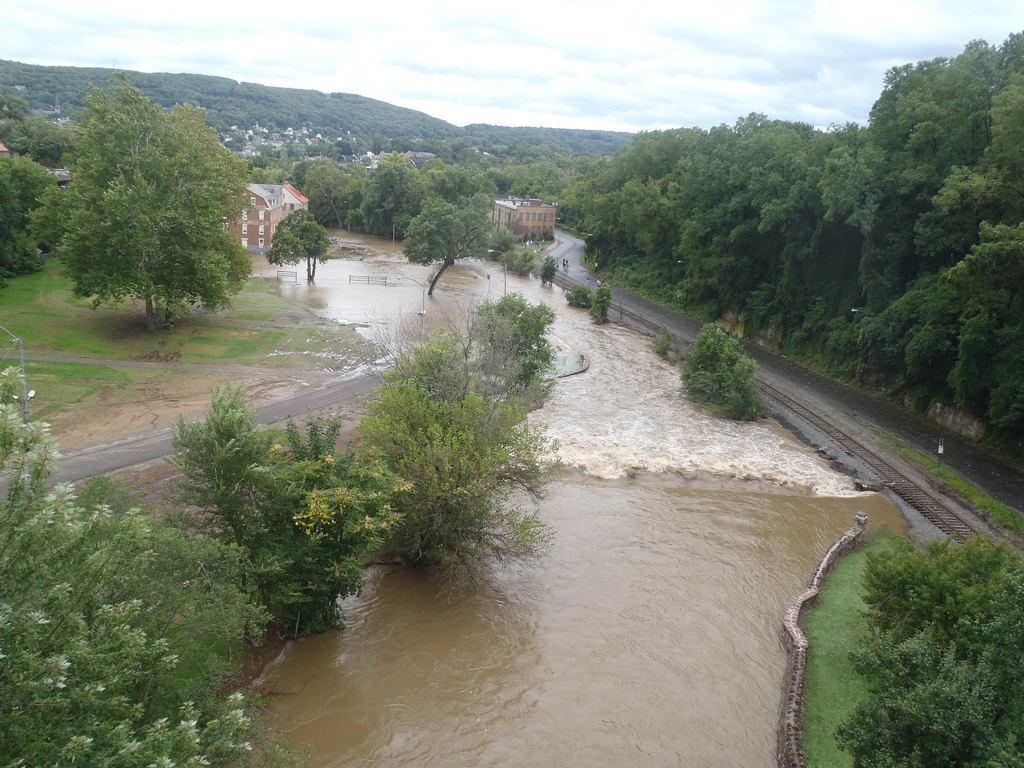By Tom Pelton
Commentary from Bay Journal
The scenic Monocacy River in central Maryland winds through Civil War battlefields, with rows of bone-white sycamores lining its banks as if they were ghostly soldiers standing at attention to demonstrate their respect.
Both Maryland and the city of Frederick promote kayaking and fishing on the waterway. But beyond this advertising to tourists, the state’s and local governments’ oversight of the river have been more passive-aggressive than respectful.
On the banks of the Monocacy, the Frederick City Wastewater Treatment Plant disgorges a waterfall of partially treated human waste carrying a gut-wrenching reek of ammonia and illegal amounts of pollution down black-stained boulders into the river.
An Environmental Integrity Project investigation of U.S. Environmental Protection Agency and state records found that Frederick’s sewage plant discharged twice its permitted limit of nitrogen pollution last year into the Monocacy —199,962 pounds, compared with the 97,458-pound limit for 2016.
The EIP’s new report, Sewage and Wastewater Treatment Plants in the Chesapeake Bay Watershed, shows that problems at the plant continued into 2017: between January and September of last year, it released 130,249 pounds of nitrogen — 34% more than its permit allows for the entire year.
Pollution hot spots
More broadly, the report discusses the problem of local pollution “hot spots” caused by pollution trading systems in Virginia and Pennsylvania, and the threat of a similar scheme proposed in Maryland.
But in terms of sewage plant permit violations, the report found that the Frederick plant is far from being alone. Across the Bay watershed, the EIP found 21 wastewater plants that violated their permit limits last year.
These included 12 in Maryland, led by the state’s second largest, Baltimore’s Patapsco Wastewater Treatment Plant, which released 317% more nitrogen than permitted in 2016. The state’s largest, the Back River sewage plant in Baltimore County, discharged 29% more than its permit allowed. And on the Eastern Shore, Salisbury’s wastewater plant discharged 302% more nitrogen than permitted last year.
Some of the sewage plants that went over their limits have upgrade projects planned or in the works, although often behind schedule.
At Baltimore’s Back River plant, a $263 million, state-of-the-art nutrient removal system was completed in September and should be online by January. At Frederick’s sewage plant beside the Monocacy River, a $40 million upgrade project is six years late — but now underway. City officials project it should be finished sometime in 2018.
Virginia and Pennsylvania
Of course, with 487 wastewater plants scattered across the Bay watershed, it is not surprising that a few would be over their pollution limits every year.
But here’s what the EIP’s research found that was most troubling: In Virginia and Pennsylvania, far more wastewater plants exceeded their permit limits than in Maryland. But Virginia and Pennsylvania judged almost none of these plants to be in violation of the law because these states engage in systems of “pollution trading.”
Trading allows polluters to essentially buy their way out of permit limits (and therefore, legal jeopardy for excessive dumping) by sending money — through the purchase of pollution credits — to other plants or facilities that pollute less.
Maryland Gov. Larry Hogan’s administration is promoting regulations to also make pollution trading a central part of his state’s plan for cleaning up the Chesapeake Bay. In theory, trading could be helpful because it could provide more flexibility and efficiency in the expenditure of funds — more “bang for the buck” — for the Bay cleanup.
But the EIP’s report discovered serious flaws in Virginia and Pennsylvania’s trading systems that should serve as a warning for Maryland. These trading schemes create local water pollution “hot spots” and undermine transparency and accountability for polluters.
The Shenandoah Valley
A compelling example is in the Shenandoah Valley, where the waterways are already overloaded with phosphorus pollution from the livestock industry and suffering severe algae blooms as a result.
Virginia’s system of pollution trading last year allowed wastewater plants up and down the valley to dump more phosphorus into the river than would normally be permitted because they purchased credits.
For example, trading allowed the Strasburg Sewage Treatment Plant to release 2,942 pounds of phosphorus, more than three times its permitted limit, into the North Fork of the Shenandoah last year. And the Front Royal Wastewater Treatment Plant dumped 9,146 pounds of phosphorus into the Shenandoah, more than twice its limit, because of trading.
“Nitrogen and phosphorus are the two primary pollutants that are being dumped,” said Mark Frondorf, the Shenandoah Riverkeeper, whose organization filed a federal lawsuit against the EPA in May because of the excessive algae fueled by phosphorus in the river. “And these pollutants are being dumped because, quite honestly, it’s cheaper, better, faster, easier for wastewater treatment plants to buy credits on the credit exchange than to actually upgrade their facilities.”
The bottom line is that the Chesapeake region’s historic waterways like the Shenandoah and Monocacy rivers deserve better protections than they are receiving today.
And the answer is stronger enforcement of pollution limits for individual plants, not trading schemes that blur the lines between legal and illegal waste dumping.
Tom Pelton is director of communications for the Environmental Integrity Project, host of the public radio program, The Environment in Focus, and author of the forthcoming book by Johns Hopkins University Press, “The Chesapeake in Focus” (March 2018).
MarylandReporter.com partners with the Bay Journal by republishing content about all aspects of the Chesapeake Bay every Friday.




Recent Comments